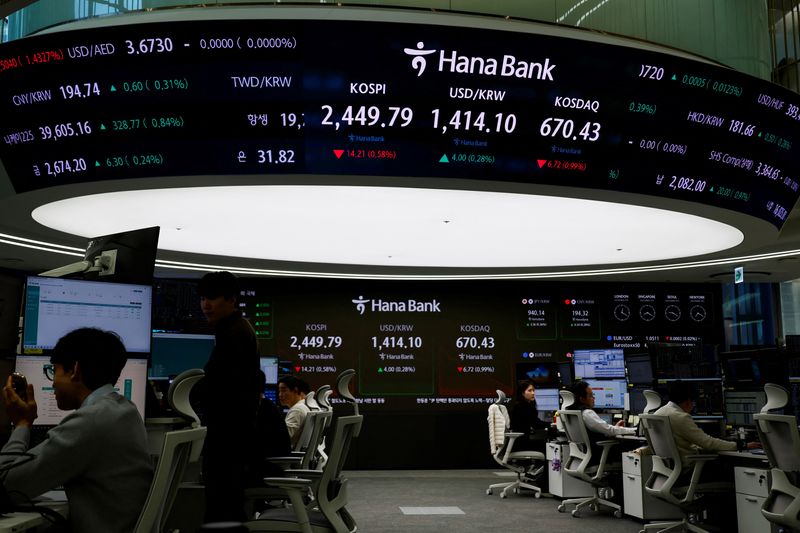By Stella Qiu
SYDNEY (Reuters) – Asian stocks slipped on Friday on political ructions in South Korea, while dollar bulls waited anxiously to see if U.S. payrolls challenged or cemented expectations of a rate cut this month.
MSCI’s broadest index of Asia-Pacific shares outside Japan fell 0.3% in part due to a 1.7% drop in South Korea’s KOSPI. The Korean won fell 0.8% to 1,425.42 per dollar, tumbling towards the low of 1,443.4 hit on Tuesday after President Yoon Suk Yeol declared martial law in the country.
South Korea’s main opposition Democratic Party said on Friday lawmakers were on standby after receiving many reports of another martial law declaration, the Yonhap news agency reported on Friday.
In other places, China’s blue chips rose 0.2% and Hong Kong’s Hang Seng gained 0.4%.
Japan’s Nikkei fell 0.6% but is up 2.5% for the week. Data showed that Japan’s local wages grew at the fastest pace in 32 years in October, although markets are still leaning towards no rate hike from the Bank of Japan this month.
All eyes are on the U.S. nonfarm payrolls report due in the day.
Forecasts are centered on a rise of 200,000 jobs in November, rebounding from a soft 12,000 gain in October when the result was impacted by hurricanes and strikes. The unemployment rate likely edged up to 4.2%, from 4.1%.
With markets priced for a Goldilocks outcome, risks abound as a really strong report could threaten the prospects of rate cuts while surprisingly soft numbers would amplify concerns about the economy.
Futures imply a 70% chance of a rate cut from the Federal Reserve on Dec. 18, suggesting the market is vulnerable to a hot jobs report, particularly as in the past week or so futures have climbed to price in an extra quarter point cut for 2025.
“An outcome that comes in below 100k with a U/E rate at 4.2%, and certainly at 4.3%, could see equity under pressure even if this all but assures a 25bp rate cut,” said Chris Weston, head of research at Pepperstone.
“Some may see a risk that an NFP print above 250k with the U/E rate at or below 4.1% could lead to markets derisking as it raises the possibility that the Fed hold off from easing on 18 Dec.”
Overnight, Wall Street retreated from record highs as investors adjusted their positions ahead of the payrolls report. The tech-heavy Nasdaq nonetheless has gained 2.5% so far this week, adding $1 trillion to its market capitalisation.
The mighty U.S. dollar fell 0.6% overnight against its peers and was pinned near three-week lows at 105.84 on Friday. Bulls are wary of a sharp pullback given the market has been overwhelmingly long on the greenback.
The euro rallied 0.7% overnight and was last flat at $1.0580, after French Prime Minister Michel Barnier resigned in a widely expected development in the country’s political saga.
BITCOIN REVERSAL
Bitcoin, which hit the $100,000 mark for the first time as investors bet on a friendly U.S. regulatory shift, ran into profit-taking. It tumbled as far as $92,092 before steadying at $98,265 on Friday, up 1% for the day.
“This spike in volatility over the last 24 hours has the hallmarks of a classic blow-off top,” said Tony Sycamore, analyst at IG.
“While we don’t see this as the end of the Bitcoin bull run, it does signal we are entering a consolidation phase in the days/weeks ahead.”
Trump late on Thursday said he was appointing former PayPal (NASDAQ:PYPL) Chief Operating Officer David Sacks to be his White House Artificial Intelligence and Crypto Czar.
In the bond market, Treasuries were steady on Friday. The two-year yield held at 4.15%, having edged up 2 basis points overnight, while 10-year benchmark Treasury yields were flat at 4.178% and little changed for the week.
Oil prices extended falls on Friday despite the decision from OPEC+ to delay a planned hike in output to April. U.S. West Texas Intermediate (WTI) slipped 0.2% to $68.18 a barrel, having dropped 0.4% overnight. [O/R]
Gold remained in a tight range and was off 0.4% at $2621.89 per ounce. It is down 1.2% for the week.

